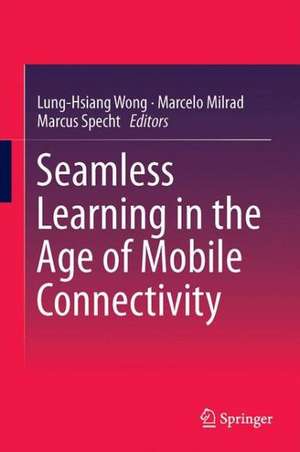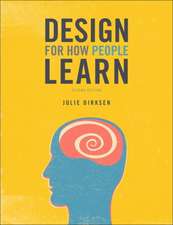Seamless Learning in the Age of Mobile Connectivity
Editat de Lung-Hsiang Wong, Marcelo Milrad, Marcus Spechten Limba Engleză Hardback – 13 noi 2014
| Toate formatele și edițiile | Preț | Express |
|---|---|---|
| Paperback (1) | 652.17 lei 6-8 săpt. | |
| Springer Nature Singapore – 22 sep 2016 | 652.17 lei 6-8 săpt. | |
| Hardback (1) | 658.70 lei 6-8 săpt. | |
| Springer Nature Singapore – 13 noi 2014 | 658.70 lei 6-8 săpt. |
Preț: 658.70 lei
Preț vechi: 774.94 lei
-15% Nou
Puncte Express: 988
Preț estimativ în valută:
126.04€ • 131.34$ • 104.36£
126.04€ • 131.34$ • 104.36£
Carte tipărită la comandă
Livrare economică 03-17 aprilie
Preluare comenzi: 021 569.72.76
Specificații
ISBN-13: 9789812871121
ISBN-10: 9812871128
Pagini: 350
Ilustrații: XXXVI, 500 p. 129 illus.
Dimensiuni: 155 x 235 x 35 mm
Greutate: 0.93 kg
Ediția:2015
Editura: Springer Nature Singapore
Colecția Springer
Locul publicării:Singapore, Singapore
ISBN-10: 9812871128
Pagini: 350
Ilustrații: XXXVI, 500 p. 129 illus.
Dimensiuni: 155 x 235 x 35 mm
Greutate: 0.93 kg
Ediția:2015
Editura: Springer Nature Singapore
Colecția Springer
Locul publicării:Singapore, Singapore
Public țintă
ResearchCuprins
Foreword by Tak-wai Chan (National Central University, Taiwan).- Preface: Editors.- Section A: Modeling and Theorizing Seamless Learning.- Chapter 1: A brief history of seamless learning.- Chapter 2: Seamless learning and context.- Chapter 3: Seamless learning in the lens of distributed intelligence.- Chapter 4: Recognising mobile devices as cultural resources and the creation of user-generated contexts for learning.- Section B: Technology Enhanced Seamless Learning.- Chapter 5: Learning Theory Mashups to support seamless knowledge, performance and well-being.- Chapter 6: Connecting learning contexts with Ambient Information Channels.- Chapter 7: A resource organization model for ubiquitous learning in seamless learning space.- Chapter 8: Supporting seamless learning using Ubiquitous Learning-Log System.- Chapter 9: Using mobile augmented reality for visualizing complex natural phenomena.- Chapter 10: Involving graduate students in the design and design research of seamless learning environments using mobile augmented reality.- Chapter 11: Applying situated learning theory to develop seamless learning.- Section C: Pedagogies and Application Domains of Seamless Learning.- Chapter 12: Mobile seamless learning and its pedagogy.- Chapter 13: Tapping into teen spirit to develop mobile applications that connect formal and informal learning about personal energy consumption.- Chapter 14: Formal-informal cycles in mobile language learning.- Chapter 15: Connecting in-class and outdoor learning activities of local cultural courses using mobile and wireless communication technologies.- Chapter 16: Learning across space and time: Using mobile digital storytelling to support learning about cultural heritage.- Chapter 17: Designing personal practicing and assessment for mobile training in the armed forces.- Chapter 18: From a simple communication tool to a learning tool: Using mobile phones for seamless learning in developing countries.- Section D: Seamless Learning in SocialContexts.- Chapter 19: Methodological issues in mobile computer-supported collaborative learning.- Chapter 20: Combining a seamless learning approach with collaborative scripts for supporting the extended classroom.- Chapter 21: Classroom and beyond as socio-technical environments.- Chapter 22: Designing the situation for pervasive Knowledge Building with mobile technology.- Chapter 24: Bridging, not formalizing?: The potential roles of social media in seamless language learning.- Section E: Seamless Learning – Bridging Research and Practice.- Chapter 25: Schooling in the age of mobilism: The biggest transformation in K-12 classrooms in 200 years.- Chapter 26: Seamless learning implementation and scale-up research.- Commentary: Editors.
Notă biografică
Dr. Lung-Hsiang Wong is a Senior Research Scientist of the Learning Sciences Lab., National institute of Education, Nanyang Technological University, Singapore. His work involves the theorization of and pedagogical design for seamless learning, mobile learning, Computer-Assisted Language Learning, Computer-Supported Collaborative Learning, and teachers’ professional development. He has published more than 150 peer-reviewed papers or chapters in journals, conferences and scholarly books and is known for developing the characterization model “10 Dimensions of Mobile-Assisted Seamless Learning.” He has co-written a scholarly book in Chinese, “Move, Language Learning – Exploring Seamless Language Learning”, to be published by Nanjing University Press.
Prof. Marcelo Milrad is a Full Professor of Media Technology at Linnaeus University, Sweden, and the director of the Center for Learning and Knowledge Technologies (CeLeKT). His current research interests include the design of learning environments to support learning about complex domains, collaborative discovery learning, and the development of mobile and wireless applications to support collaborative learning. He was one of the seventeen scholars who co-authored the seminal paper on seamless learning, namely, Chan et al. (2006).
Prof. Dr. Marcus Specht is Professor for Advanced Learning Technologies at Welten Institute (Research Center for Learning, Teaching and Technology) at the Open University of the Netherlands and director oft the Learning Innovation Labs. He received his Diploma in Psychology in 1995 and a Dissertation from the University of Trier in 1998 on adaptive information technology. From 2001 he headed the department "Mobile Knowledge" at the Fraunhofer Institute for Applied Information Technology (FIT). His researchfocus is on Mobile and Contextualized Learning Technologies and Social and Immersive Media for Learning. Prof. Specht is an Apple Distinguished Educator and since 2013 President of the International Association of Mobile Learning.
Prof. Marcelo Milrad is a Full Professor of Media Technology at Linnaeus University, Sweden, and the director of the Center for Learning and Knowledge Technologies (CeLeKT). His current research interests include the design of learning environments to support learning about complex domains, collaborative discovery learning, and the development of mobile and wireless applications to support collaborative learning. He was one of the seventeen scholars who co-authored the seminal paper on seamless learning, namely, Chan et al. (2006).
Prof. Dr. Marcus Specht is Professor for Advanced Learning Technologies at Welten Institute (Research Center for Learning, Teaching and Technology) at the Open University of the Netherlands and director oft the Learning Innovation Labs. He received his Diploma in Psychology in 1995 and a Dissertation from the University of Trier in 1998 on adaptive information technology. From 2001 he headed the department "Mobile Knowledge" at the Fraunhofer Institute for Applied Information Technology (FIT). His researchfocus is on Mobile and Contextualized Learning Technologies and Social and Immersive Media for Learning. Prof. Specht is an Apple Distinguished Educator and since 2013 President of the International Association of Mobile Learning.
Textul de pe ultima copertă
The book departs from the approach of related titles by focusing on describing and reflecting upon the notion of seamless learning with regard to salient characteristics of learner mobility and bridging of learning experiences across learning spaces. It is the first such work that is solely dedicated to research on and the practice of seamless learning, uniquely combining interpretations, visions, and past research on and practices in seamless learning from diversified perspectives. The book also strikes a good balance between theoretical and practical perspectivess, going beyond a collection of reports on specific research projects. Instead of thick descriptions of research processes and findings, readers will find significant insights and food for thought intended to inspire further advances in the research on and practice of seamless learning.
Caracteristici
The first book that is solely dedicated to the research and practice in seamless learning Focuses on explicating and reflecting upon the notion of seamless learning in the salient characteristics of learner mobility and bridging of learning experiences across learning spaces A unique effort to consolidate interpretations, visions and past research and practices on seamless learning from diversified perspectives Includes supplementary material: sn.pub/extras











